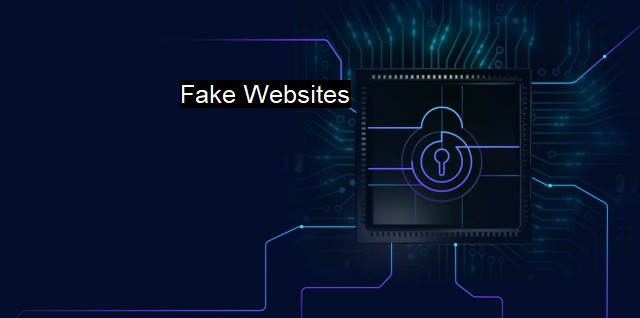What are Fake Websites?
Beware of Fake Websites: The Growing Threat of Scam Schemes Online and Their Dangers
"Fake websites" are internet sites that are created with the intent of misleading users; They might imitate genuine sites to trick users into providing sensitive information such as usernames, passwords or financial details. These sites, often fraudulent, could also host malware that installs itself onto a user's device, targeting to gain unauthorized access to their personal data and networking systems.Creating a fake website is a common practice among ethical hackers and cybercriminals. An ethically-operated fake website aims to improve security by testing the potential vulnerabilities of a network or computer system. It provides cybersecurity professionals and antivirus companies valuable insight for improving security systems, ensuring that they are prepared against the growing number of online threats. when a fake website is created by malicious entities, they become portals for all sorts of cyber threats, such as phishing, data breaching, fraud, viruses, and other damaging malware.
The rise of e-commerce and digital banking gave way to a massively-wide application for fake websites. Cybercriminals commonly erect these fraudulent storefronts and platforms with the same strategic goal – to deceive online users into entering their data or clicking on links that lead to malware download. These websites are convincingly designed to look exactly like real websites users would normally trust.
One of the popular usages of fake websites is through "phishing". Phishing attackers masquerade fake websites as familiar entities, like banks or popular online marketplaces, and convincingly ask targeted victims to enter their personal information supposedly for verification or update. Once an unsuspecting user feeds their information, these details are transmitted to these attackers who can exploit the data for various malicious purposes.
Similarly, a fake website is also culturally synonymous with malicious downloads. The website prompts the user through a pop-up to download software updates or HTML links, which are disguised bots, viruses, or other types of malicious scripts. Unknowingly welcomed into the user's system, these digitally hazardous pieces could alter files, affect system performance, break components or worst, operate in the background stealthily collecting data without the knowledge or consent of the user.
Spotting fake websites requires browser savvy and a keen eye for detail. To protect oneself, users should watch for telltale signs such as poor grammar and spelling; payment methods that do not secure user information, such as wire transfer; and suspiciously lowered prices for expensive items. The padlock icon that often depicts security can also be fraudulent. It is, therefore, a best practice to also check the site’s URL for anomalies, like atypical spelling and format variations intended to lure victims.
Another measure to prevent falling prey to fake websites is to invest in a cybersecurity framework, including a robust antivirus program. An antivirus software guards your system from malware lurking on fake websites. It can flag these websites and prohibit your access. It also scans downloaded files and automatically segregates potential threats.
"fake websites" dwell around the realm of cyber threats can potentially impose significant risks on security. Combating these, users and businesses alike should place immense importance on cybersecurity, promoting not just the ability to identify fake websites but also encouraging and adopting the practice of taking solid security measures, more specifically, in placing trust in adept antivirus systems just as much as nurturing keen attention to detail when parsing the seas of internet sites. Investing in these disciplines to fortified cybersecurity demonstrates precaution, which in this time of advanced cyber warfare, is better than any antivirus cure.

Fake Websites FAQs
What are fake websites?
Fake websites are fraudulent websites that are designed to mimic legitimate websites to trick users into providing sensitive information or downloading harmful software. These websites often have similar web addresses or URLs to the real websites and use familiar logos, designs, and layouts to appear authentic.How do I identify fake websites?
To identify fake websites, you should pay attention to the web address or URL, the design and layout, and the content of the website. Check for spelling errors or inconsistencies in the web address or URL, and look out for unusual or suspicious web domains. You should also be wary of websites that have poor-quality graphics or a different design from the real website. Lastly, check for unusual or suspicious content on the website, such as requests for personal information or offers that seem too good to be true.Why are fake websites dangerous?
Fake websites are dangerous because they can steal your personal and financial information, infect your computer with malware, or use your browsing behavior to deliver targeted ads. They can also compromise your online security and privacy, making you vulnerable to cyber attacks and identity theft.How can I protect myself from fake websites?
To protect yourself from fake websites, you should use reputable antivirus software that can detect and block malicious websites. You should also be careful when entering personal information online and avoid clicking on suspicious links or downloading unknown software. Always check the website address or URL before entering any sensitive information, and use strong and unique passwords for each website. Lastly, stay informed about the latest cybersecurity threats and scams to stay ahead of the game.| | A | | | B | | | C | | | D | | | E | | | F | | | G | | | H | | | I | | | J | | | K | | | L | | | M | |
| | N | | | O | | | P | | | Q | | | R | | | S | | | T | | | U | | | V | | | W | | | X | | | Y | | | Z | |
| | 1 | | | 2 | | | 3 | | | 4 | | | 7 | | | 8 | | |||||||